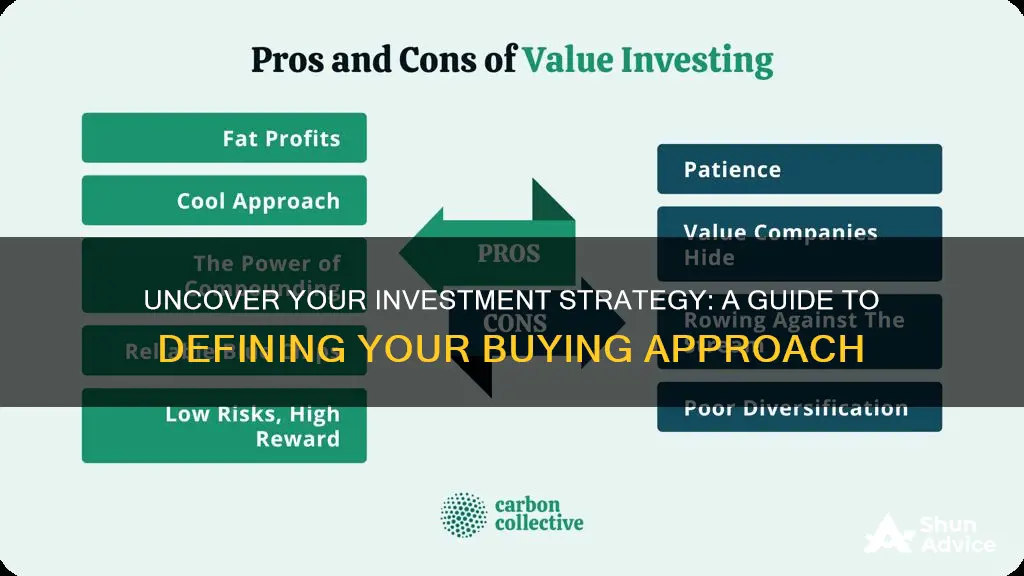
Investing is a wide world, and there are many different strategies that investors can use to build their portfolios. One popular strategy is buy and hold, where investors buy stocks or other securities and hold them for a long time, sometimes decades, without selling. This strategy is passive and focuses on long-term gains rather than short-term price movements. Another strategy is dollar-cost averaging, where investors put a consistent sum of money into an investment at regular intervals, regardless of market fluctuations. This strategy helps investors avoid the risk of timing the market. Passive index investing is another popular strategy, where investors put their money into index-tracking mutual or exchange-traded funds (ETFs), offering built-in diversification and a hands-off approach.
| Characteristics | Values |
|---|---|
| Time horizon | Long-term |
| Active vs. passive | Passive |
| Risk tolerance | Higher risk |
| Investment choices | Value stocks, growth stocks, index funds, ETFs, individual stocks |
| Taxes | Defer capital gains taxes |
| Buying strategy | Buy-and-hold |
| Selling strategy | Don't sell |
| Investment decisions | Based on long-term investment theses |
| Monitoring investments | Minimal monitoring required |
| Tactical errors | Low risk |
| Risk management | Simple risk management strategies may be neglected |
| Profit from market volatility | No |
What You'll Learn

Passive Index Investing
The benefits of Passive Index Investing include:
- Ultra-low fees: There are minimal fees as there is no need for extensive research or active decision-making.
- Transparency: Investors know what assets are in the fund at all times.
- Tax efficiency: The buy-and-hold approach avoids frequent trades, reducing capital gains taxes.
- Simplicity: It is easier to implement and comprehend than dynamic strategies that require constant adjustments.
- Diversification: By mirroring a market index, investors reduce risk by investing in a variety of asset classes and industries.
However, there are also some drawbacks to Passive Index Investing:
- Total market risk: When the overall market falls, so do the index funds.
- Lack of flexibility: Fund managers may be prohibited from taking defensive measures, such as reducing shares, even if they anticipate a decline.
- Performance constraints: These funds are designed to closely track the benchmark index, so they rarely beat the market and may return slightly less due to operating costs.
- Limited investment options: Investors cannot handpick specific investments and are locked into the holdings of the chosen index.
- Smaller potential returns: Passive funds will rarely outperform the market and usually return slightly less.
The Joint Investment Conundrum: Will or Won't?
You may want to see also

Value Investing
Principles of Value Investing
Value investors believe that share prices do not always reflect a company's long-term fundamentals because they are heavily influenced by market behaviour. They employ a contrarian investment approach, often moving in the opposite direction of the market. The principle behind value investing is to buy stocks when they are undervalued and sell them when they reach or exceed their intrinsic value. Value investors also allow for a margin of safety when trading.
How to Identify Undervalued Stocks
To identify undervalued stocks, value investors analyse a company's financial history, revenues, cash flows, business model, profits, and future profitability. They also consider qualitative indicators such as financial scams, credit ratings, and performance during previous market recessions. Additionally, they use financial metrics like Earnings Before Interests and Taxes (EBIT), Earnings Before Interests, Taxes, Depreciation, and Amortisation (EBITDA), and discounted cash flow analysis to assess a company's intrinsic value.
Advantages of Value Investing
Disadvantages of Value Investing
One of the main disadvantages of value investing is that it is a long-term investment strategy that may not provide higher returns in the short run, requiring investors to lock in their capital for an extended period. It also demands a significant amount of time and dedication to seek out undervalued companies using qualitative and quantitative analysis.
Strategies for Value Investing
The key strategy for investing in undervalued stocks is to utilise financial metrics such as EBITDA, EBIT, and the Price-to-Earnings (P/E) ratio. Investors should analyse a company's intrinsic value and focus on its business fundamentals rather than its stock price. It is also important to believe in the principles the company represents and only invest in businesses you understand, with good, strong management. While diversification is important, over-diversification can be challenging to manage.
Investing's Cash Flow Conundrum: Why Negative is the Norm
You may want to see also

Growth Investing
Growth investors tend to favour smaller, younger companies that are poised to expand and increase profitability potential in the future. They look for companies with strong growth potential and market advantages, such as strong customer loyalty, a valuable brand, or a formidable competitive moat.
Growth stocks tend to be high-risk, high-reward investments. They can provide higher returns over time, but they are also subject to volatility, making them suitable for long-term investors who can tolerate market fluctuations.
Identifying Growth Stocks
Growth investors look for companies with the following characteristics:
- High-growth industries: Growth investors tend to invest in companies in industries expected to grow faster than others, such as technology and healthcare.
- Economies of scale and competitive advantages: Companies with competitive advantages like network effects, scale advantages, and high switching costs are more likely to weather market downturns and reinvest profits to grow faster than their competition.
- High price-to-earnings ratios: Growth stocks can have higher price-to-earnings ratios than value stocks, indicating that they are priced at a premium due to investors' optimism.
Growth vs. Value Investing
Implementing a Growth Investing Strategy
When implementing a growth investing strategy, it is important to prepare financially and ensure that the cash being invested won't be needed in the short term. It is also crucial to diversify by investing in growth-focused funds or selectively purchasing individual growth stocks.
Growth investors should focus on industries and companies they know well, as this knowledge will help evaluate potential investments. It is recommended to start small and gradually increase the allocation towards growth stocks as comfort and experience grow.
Maximizing Returns
Growth stocks tend to be volatile, and while the aim is to hold each investment for several years, it is important to monitor significant pricing changes. If a stock rises far above its estimated value, it may be worth selling, especially if there are other, more reasonably priced investments available.
Benefits and Risks of Growth Investing
Overall, growth investing is a strategy that focuses on finding companies with strong growth potential and investing for the long term, but it comes with higher risk and volatility compared to other investment approaches.
Millionaires' Mindset: Pay Off Debt or Invest?
You may want to see also

Momentum Investing
The core principle of momentum investing is to capitalise on the continuation of an existing market trend. It assumes that upward or downward trends in stock or ETF prices will continue due to the momentum already behind them.
Momentum investors look for stocks that are rising and aim to sell them when they appear to have peaked. This can be identified by analysing chart patterns, such as new 52-week highs or resistance levels being broken, or higher-than-average volume.
There are several ways to implement a momentum investing strategy. One approach involves investing in the best-performing stocks over the past six months and then holding them for the subsequent six months. Another strategy is to short-sell the worst-performing stocks from the past six months and then buy them back at a lower price.
While momentum investing has been a well-established phenomenon for over 200 years, there is no consensus on why this strategy works. Some economists believe it contradicts the efficient market hypothesis and random walk hypothesis. However, a 1993 study and other academic research have confirmed that this strategy can generate higher returns than the overall market.
Understanding Initial Group Retirement Investments: A Guide to Getting Started
You may want to see also

Dollar-Cost Averaging
A prime example of long-term dollar-cost averaging is its use in 401(k) plans, in which employees invest regularly regardless of the price of the investment. With a 401(k) plan, employees can choose the amount they wish to contribute, and then investments are made automatically every pay period. Dollar-cost averaging can also be used outside of 401(k) plans, such as with mutual or index funds.
However, dollar-cost averaging may not be suitable for those investing in periods when prices are trending steadily in one direction. It is important to consider your outlook for the investment and the broader market when deciding to use this strategy. Additionally, the repeated investing called for by dollar-cost averaging may result in higher transaction costs compared to investing a lump sum of money once.
Overall, dollar-cost averaging is a strategy that can help investors manage risk and deal with uncertain markets. By investing a fixed amount at regular intervals, investors can lower their average purchase price and benefit from buying more shares when prices are lower.
Shark Tank: Payback Time?
You may want to see also
Frequently asked questions
A buy-and-hold strategy is a passive investment strategy where an investor buys stocks or other types of securities and holds them for a long period, regardless of fluctuations in the market. This strategy is simple to execute and focuses on the long-term performance of a company rather than short-term price movements.
The buy-and-hold strategy is simple and requires less active management from the investor. It also allows investors to defer capital gains taxes and typically outperforms active management strategies over longer time horizons.
Critics argue that investors using a buy-and-hold strategy may not sell at optimal times and may be exposed to higher risk by holding through market downturns.
To implement a buy-and-hold strategy, investors should focus on owning shares of companies with strong business fundamentals and a well-thought-out investment thesis. This strategy involves making long-term investment decisions and holding onto shares as long as the company continues to perform well.







